Submitted:
16 October 2023
Posted:
19 October 2023
You are already at the latest version
Abstract
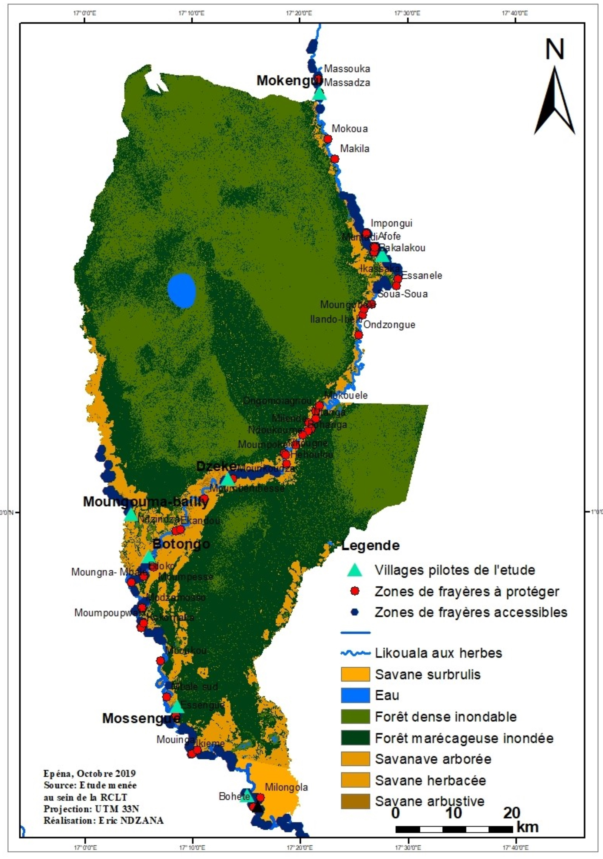
Keywords:
1. Introduction
2. Materials and Methods
- -
- 1st station: Upstream of the village (Northern limit with the spawning grounds) (i)
- -
- 2nd station: Village area (near the main port of the village) (ii)
- -
- 3rd station: Downstream of the village (southern limit with spawning grounds) (iii)
| Q = V X S | with | V = Flow velocity in m/s |
| S = wetted area in m2 | ||
| Q = flow in m3/s |
3. Results
3.1. Descption of differents results
3.1.1. Spatio-temporal dynamics of land use in the Likouala aux Herbes watershed between 1980, 2000 and 2018
- we observe a predominance of dense and swampy forests and savannah dynamics around the catchment area of the Likouala river with herbs, i.e.: 2.29% (10,340.55 ha) of the area of the RCLT in 1980, 9 .37% (7,716.3ha) in 2000 and 13.35% (60,281.64 ha) in 2018 (Figure A1);
- The analysis reveals that the dense floodplain forest and the swamp forest have remained substantially unchanged i.e. respectively (203,404.59 ha) 45% of the area of the LTCR and (184,343.85 ha) 40.8% of the LTCR between 1980 and 2018;
- The water superficies’ have also remained constant regardless of their evolution over time and the different dry and rainy seasons, or 0.7% (3,423.06 ha) of the area of the LTCR. Table A2 and Table A3 show the variation in land use areas between the different periods;
- The occupation classes: seasonally flooded gallery forest and herbaceous savannah were converted respectively by 24.11% and 65% into shrubby savannah and wooded savannah.
- From 2000 to 2018, the occupation classes : water, swamp forest and dense floodplain forest have remained practically unchanged as in the dynamics of the previous period ;
- However, according to the observation of Figure A1 and the analysis of Table A2, it can be said that the savannah class composed in 2,000 of herbaceous savannah 0.58%, 0.7% tree savannah and 1.7% shrubby savannah were completely converted respectively into slash and burn savannah, shrubby, wooded and herbaceous savannah in 2018, as shown in Figure A1.
3.1.2. Characterization of the ichthyological diversity of the Likouala aux herbes river
- One thousand one hundred and six (1106) fish in total were harvested, divided into 25 genera belonging to 13 families (Table A4);
- The Clariidae family was the most abundant with 381 specimens (Figure A3) representing 34.07%, followed by the Mochokidae family with 208 individuals, or 19.67%. The Bouanela and Mossengue stations contain the largest numbers of individuals, representing respectively 20.61% and 31.1%, while the Moungouma-Bailly and Dzeke stations recorded the lowest numbers of 8 and 28 individuals, i.e. 0.72% and 2 .53% (Figure A3 and Table A4 and Table A5);
- In axis II of the Principal Composant Aanalysis (Component 2, Figure A2 (a)), the distribution of the families Alestidae and Mormyridae was influenced by the presence of sandy type substrates, foliage and macrophytes coupled with the increase in temperature of the 'water (Table A4 and Table A5). The presence of Alestidae according to (Component 2, Figure A2 (b)), is correlated with temperature peaks, namely 28.79 ± 1.7°C for the Botongo station and 28.13 ± 1.17°C for the Epena station (Table A5). As for the Mormyridae, the highest diversity indices in this case; 0.6229 for Mossengue and 0.5993 for Botongo were recorded at the stations with the highest temperature peaks.
- The families of Dichtichodontidae, Hepsetidae, Notopteridae, Anabantidae, Schilbeidae and Polypteridae show no affinity either with the different substrates recorded or with the physico-chemical parameters (Table A4 and Table A5)of the water in axis III, paradoxically to the distribution of the previous families of fish species presented in axes I and II (Figure A2) and (Table A5).
3.2. Figures, Tables and Schemes
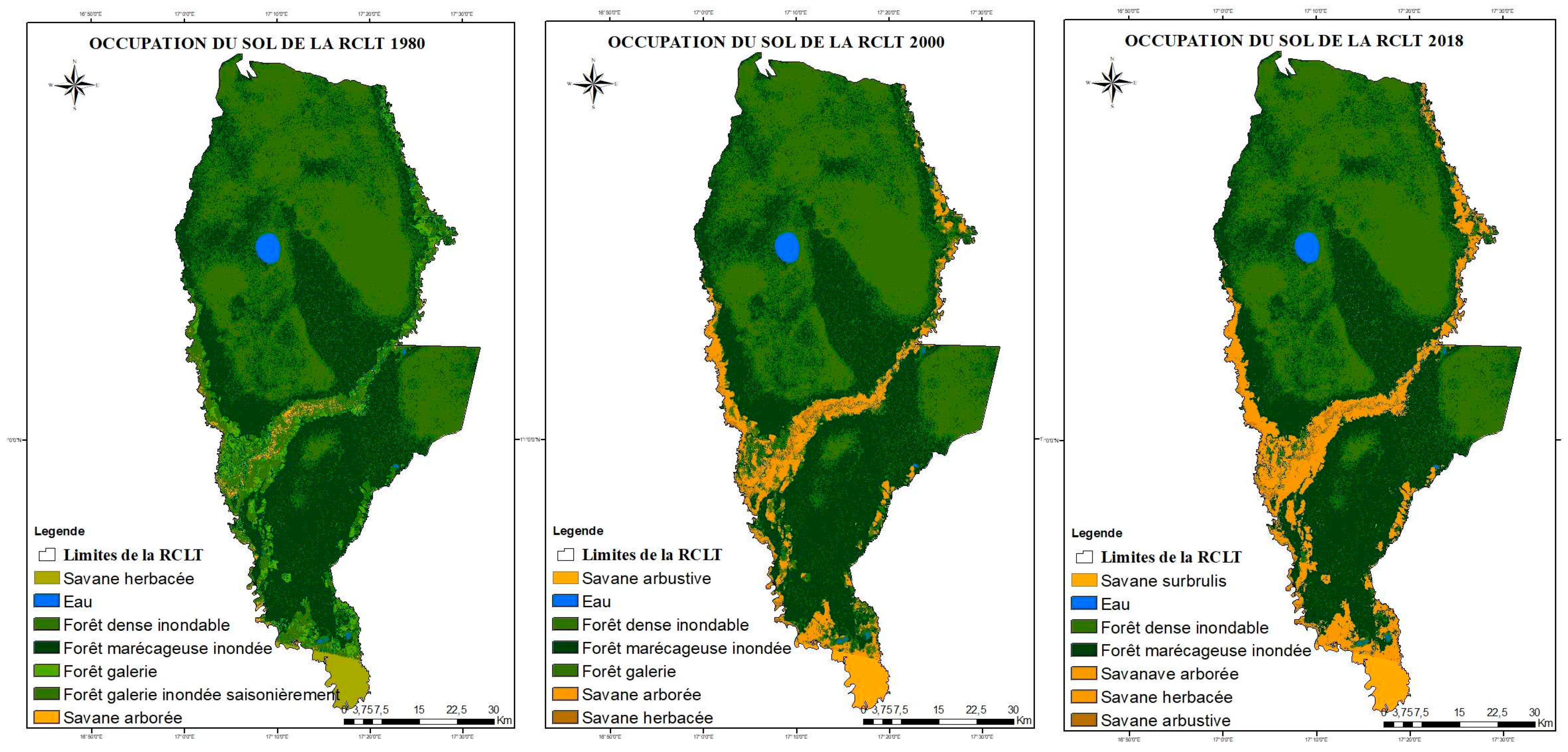
| Land cover (ha) | 1980 | 2000 | 2018 |
|---|---|---|---|
| Grassy savannah (ha) | 7708,68 | 2631,87 | 31972,86 |
| Wetlands (ha) | 3423,06 | 3423,06 | 3423,06 |
| Flood dense forest (ha) | 203404,59 | 203404,59 | 203404,59 |
| Flooded swamp forest (ha) | 184343,85 | 184343,85 | 184343,85 |
| Gallery forest (ha) | 17968,23 | 17968,23 | 17968,23 |
| Seasonally flooded gallery forest | 31972,86 | 7708,68 | 7708,68 |
| Tree savannah (ha) | 2631,87 | 31972,86 | 2631,87 |
| TOTAL (ha) | 451453,14 | 451453,14 | 451453,14 |
| Areas (ha) | Variation of areas (ha%) | |||
|---|---|---|---|---|
| Land cover | 1980 | 2000 | (ha) | % |
| Grassy savannah (ha) | 7708,68 | 2631,87 | +5076,81 | + 65,85 |
| Wetlands (ha) | 3423,06 | 3423,00 | 0,00 | 0 |
| Flood dense forest (ha) | 203404,59 | 203404,59 | 0,00 | 0 |
| Flooded swamp forest (ha) | 184343,85 | 184343,85 | 0,00 | 0 |
| Gallery forest (ha) | 17968,23 | 17968,23 | 0,00 | 0 |
| Seasonally flooded gallery forest (ha) | 31972,86 | 7708,68 | -31 904,86 | - 24,11 |
| Tree savannah (ha) | 2631,87 | 31972,86 | -29 340,13 | 9,23 |
| TOTAL | 451453,14 | 451453,14 | 100,00 | |
| Areas (ha) | Variation of areas (ha et %) | |||
|---|---|---|---|---|
| Land cover units | 2000 | 2018 | (ha) | % |
| Grassy savannah | 7708,68 | 7708,68 | 0,00 | 0 |
| Wetlands | 3423,06 | 3423,06 | 0,00 | 0 |
| Flood dense forest | 203404,59 | 203404,59 | 0,00 | 0 |
| Flooded swamp forest | 184343,85 | 184343,85 | 0,00 | 0 |
| Gallery forest | 17968,23 | 12339,77 | -5623,23 | - 31,29 |
| Tree savannah | 31972,86 | 44917,86 | +12 944,86 | + 15,48 |
| Overburn Savannah | 2631,87 | 1231,87 | -1403,00 | + 53,3 |
| TOTAL | 451453,14 | 451453,14 | 100,00 | |
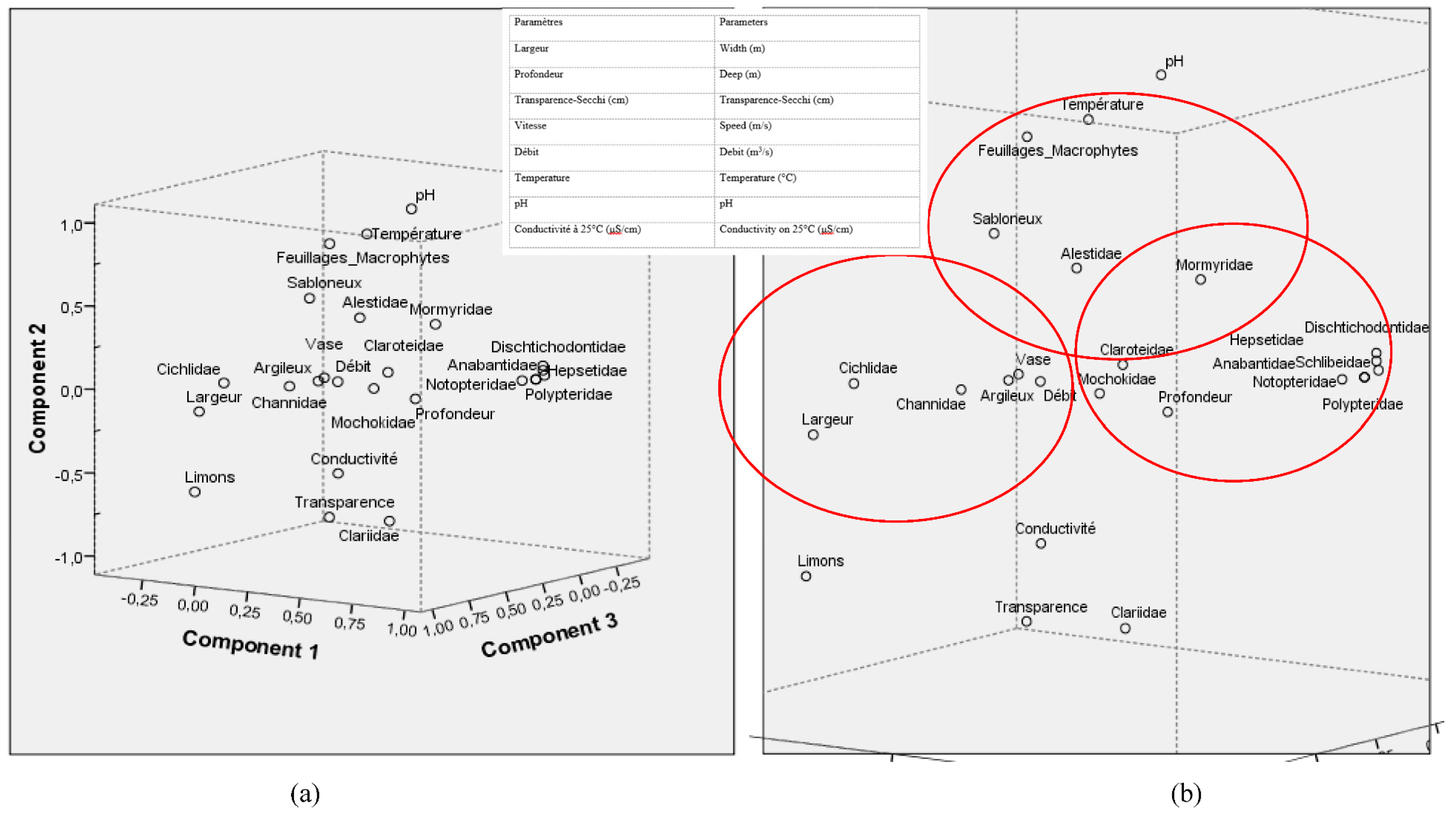
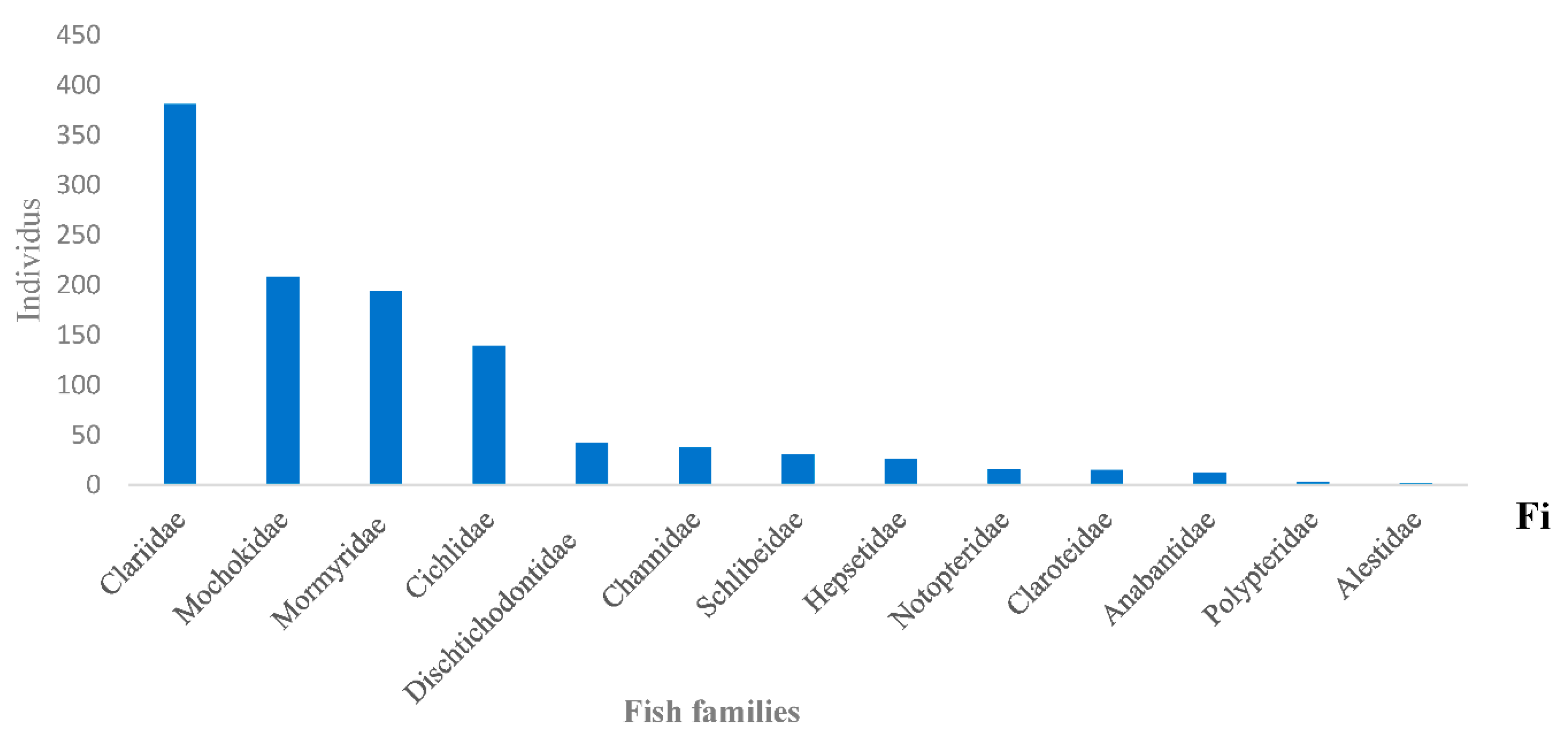

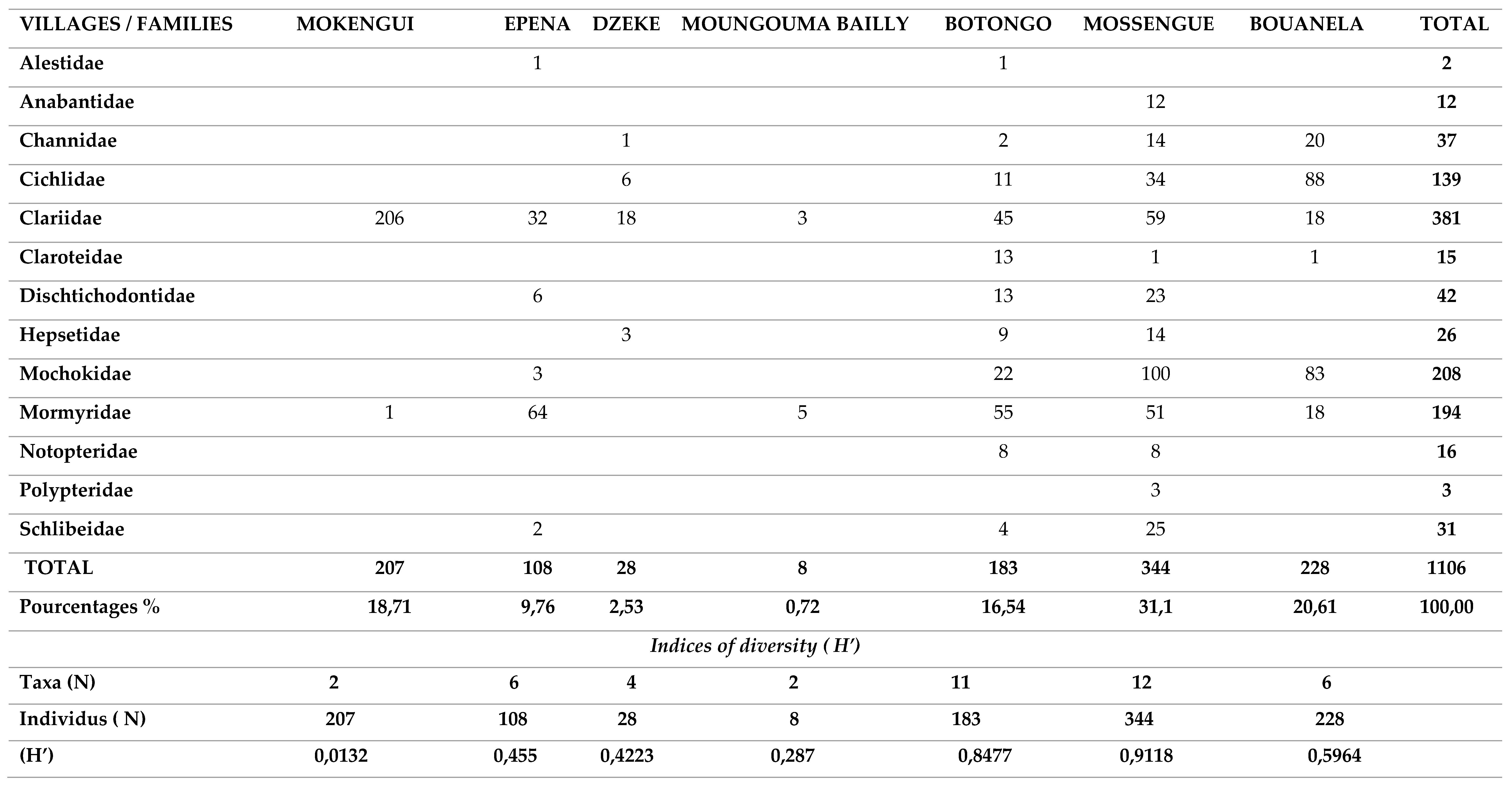
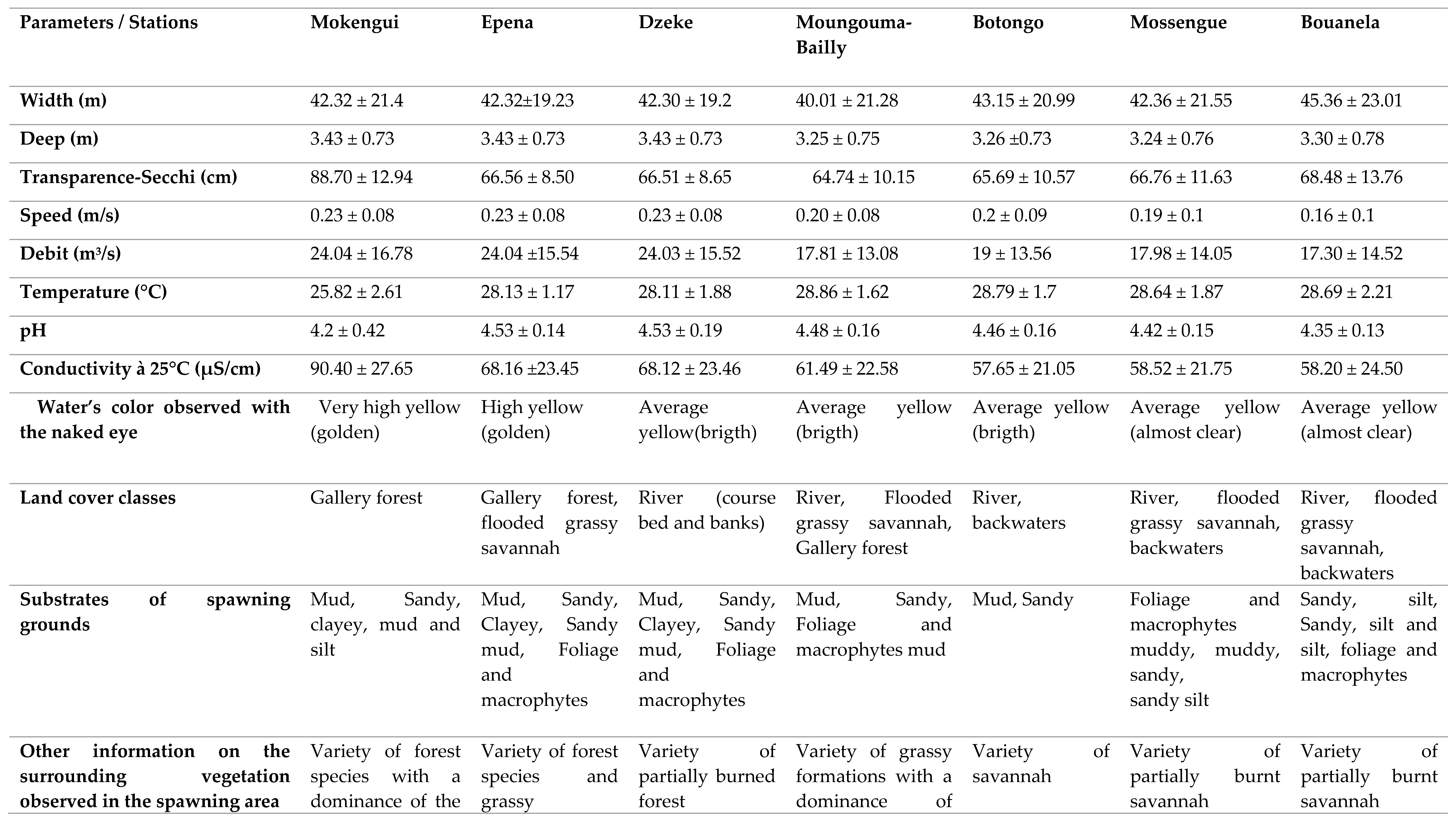

4. Discussion
5. Conclusions
- To know the distribution dynamics of fish species populations during the period from July to September 2019 in the LTCR;
- To locate and characterize the 204 spawning grounds of the Likouala aux Herbes fisheries
Author Contributions
Funding
Institutional Review Board Statement
Informed Consent Statement
Data Availability Statement
Acknowledgments
Conflicts of Interest
References
- Ashley B, Robin A. Ecoregion 539: Upper Congo Rapids in Freshwater ecoregion of the world 2008. Conservation Science Program, WWF-US: Washington, DC, USA., pp. 234-235.
- Byanikiro Richard Mahamba, A.B.; Jacob Ndjaki Nsila, C.D.; Alidor Kankonda Busanga, E.F.; Joseph Ulyelali-patho,G.H.; Jean-Claude MICHA,I.J. Caractérisation et écologie des peuplements des mormyridae dans la réserve de Yoko (Kisangani, RD Congo). International Journal of Biological and Chemical Sciences 2017, pp.13-15.
- Mamonekene Victor, A.B. Les ressources halieutiques de la Réserve communautaire du Lac Télé Likouala aux Herbes. Diversité et exploitation, Rapport de consultance 2006.
- Micha Jean Claude, A. Défis dans la conservation du poisson dans les aires protégées du bassin du Congo, 2019, La Revue Nature & Faune Volume 32, Numéro 2, 69 – 74. http://www.fao.org/3/ca4151fr/ca4151fr.pdf.
- Micha Jean Claude,A.B. ; Shango Mutambue,C.D.; Felin Twagirashyaka, E.F., Roger Mobongo,G.H., Parfait Bakabana, I..J., Thierry Mangonga,K.L. Plan d’aménagement et de gestion des zones humides de la réserve communautaire du lac Télé 2016, République du Congo (PAGZHRCLT),pp. 4-5.
- Moutsambote A.B. ; Rapport de mission botanique effectuée au lac Télé (District d'Epéna, Likouala) 08-27 juin 1992, Laboratoire de Botanique, CERVE, Brazzaville, Congo, pp.6.
- Paugy D A.B. ; Lévêque C.C.D. ; Teugels GG, E.F. Poissons d’Eaux Douces et Saumâtres de l’Afrique de l’Ouest, Edition ORSTORM, (Tome I et II), Institut français de recherche scientifique pour le développement en coopération, Paris, France, 1990, ; pp. 56.
- Poll M, Gosse JP.A.B. Généra des Poissons d’Eau Douce de l’Afrique (eds). Académie Royale de Belgique : Bruxelles. 1995, pp.15.
- Pwema Kamfu A.B. ; Nseu Mbomba Bekeli C.D. ; Lise-marie Pigneur E.F. ; Takoy Lomema, G.H. ; Jean-Claude MICHA, Environmental variables structuring Labeo species (Pisces, Cyprinidae) in Malebo Pool, Congo River ; International Journal of Biological and Chemical Sciences 2011, Democratic Republic of Congo, pp.34-38.
- Taibou Ba, A.B.; Dieynaba Seck. C.D. Dynamique de L’Occupation des sols, cartographie des CLPA, des zones de pêche et mise en place d’un système d’information géographique. Centre de Suivi Ecologique et USAID/COMFISH Project 2012, Senegal, University of Rhode Island, Narragansett RI, 66 pp.
- Tomedi Eyango M., A.B. ; Efole E.T., C.D. ; Blé M.C., E.F. ; Ndzana B.E.B., G.H. ; Songmo B. L., I.J. ; Nyamsi Tchatcho N. L., I.J. ; Mikolasek O., L.M. ; Tchoumbougnang F., N.O. ; Rizipisciculture : voie d’intensification écologique des systèmes piscicoles extensifs F.Tech&Doc. Vul. : 18-23-Volume spécial 2015, CRO : Centre de Recherche Océanographique d’Abidjan. Côte d’Ivoire, pp.30-32.
- Zakariyao Koumoi,A.B. ; Abdourazakou Alassane,C.D. ; Minkilabe Djangbedja,E.F. ; Tchaa Boukpessi, G.H. ; Ama-Edi Kouya I.J.; Dynamique spatio-temporelle de l’occupation du sol dans le centre-togo. ahoho - Revue de Géographie du LARDYMES, Université de Lomé, 2013, 7 (10), pp.163-172. <hal-01564256>.
- Zebaze Togouet S. H., A.B. ; Njine T., C.D. ; Kemka N., E.F. ; Foto Menbohan S., G.H. ; Niyitegeka D., I.J. ; Ngassam P. K.L. ; Boutin C., M.N. Composition et distribution spatio-temporelle des protozoaires ciliés dans un petit lac hyper trophique du Cameroun (Afrique Centrale). Revue Science Eau 2006, Volume 19, pp. 151-162.
Disclaimer/Publisher’s Note: The statements, opinions and data contained in all publications are solely those of the individual author(s) and contributor(s) and not of MDPI and/or the editor(s). MDPI and/or the editor(s) disclaim responsibility for any injury to people or property resulting from any ideas, methods, instructions or products referred to in the content. |
© 2023 by the authors. Licensee MDPI, Basel, Switzerland. This article is an open access article distributed under the terms and conditions of the Creative Commons Attribution (CC BY) license (http://creativecommons.org/licenses/by/4.0/).





